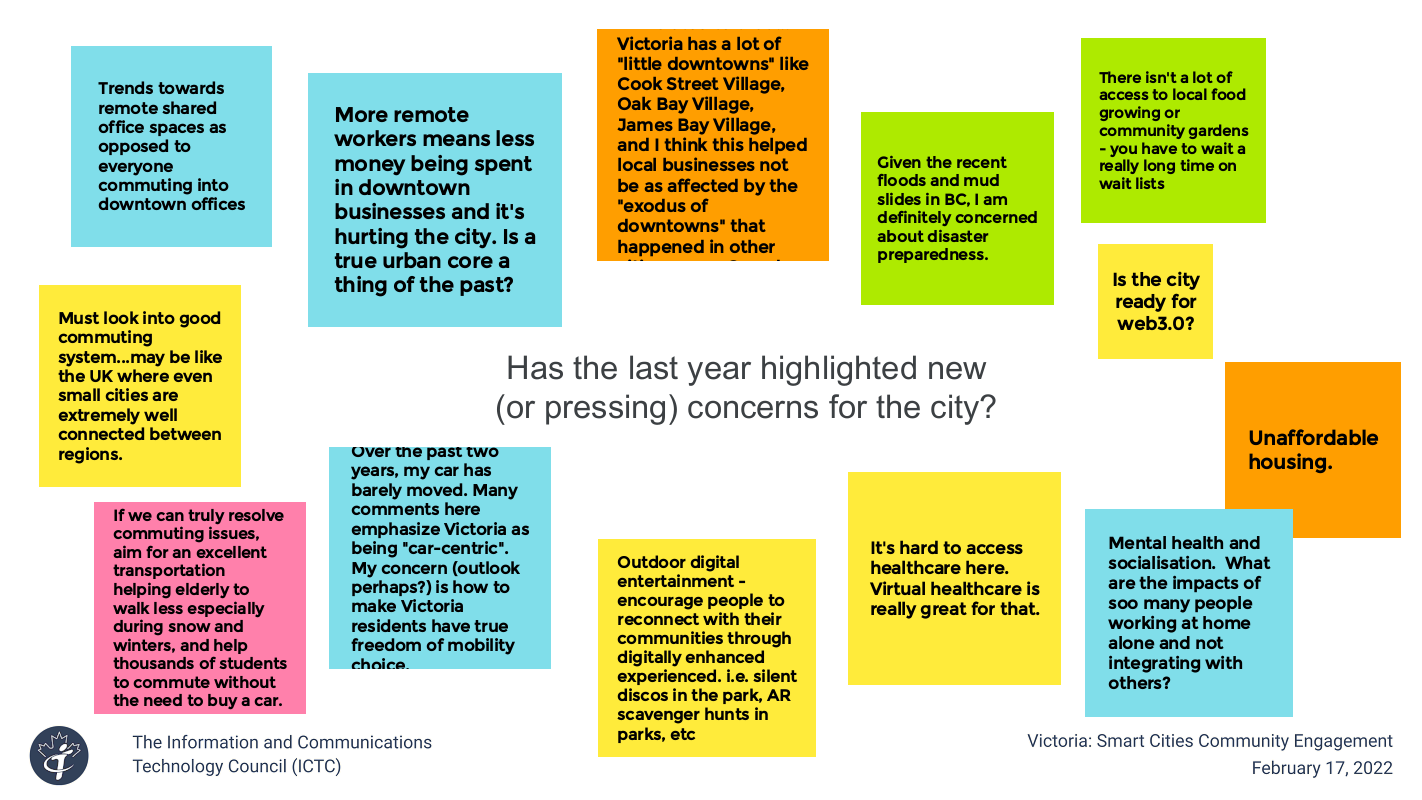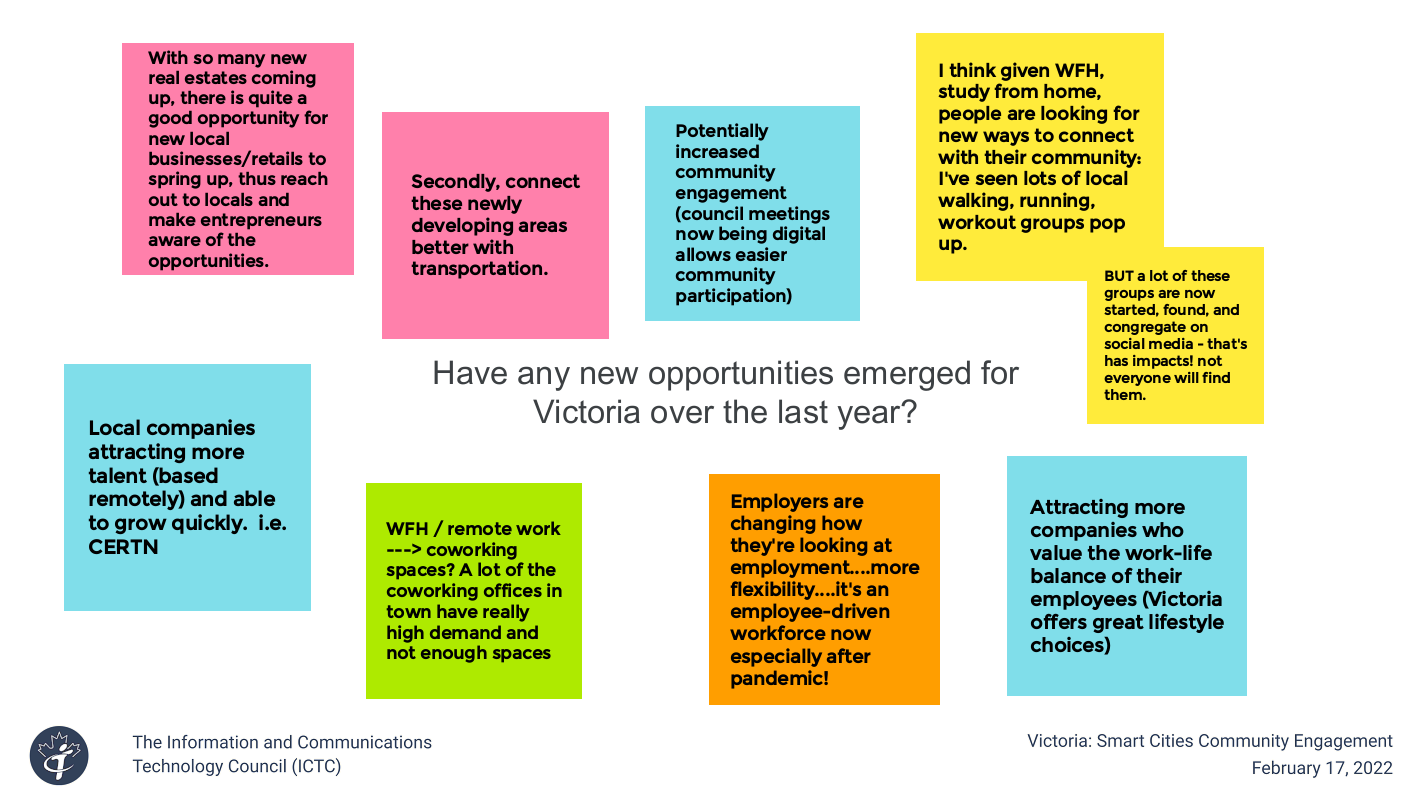Land Acknowledgement: The City of Victoria smart city engagement session engaged residents living on the lands of the Lekwungen peoples, the Songhees, and Esquimalt Nations.
On February 17, 2022, the Information and Communications Technology Council (ICTC) partnered with Esri Canada to host ICTC’s eighth smart cities community engagement session. The City of Victoria session was the most recent instalment of ICTC’s multi-year, smart cities research initiative, which engages residents and community leaders across Canada to better understand their community’s experience with smart cities. Each session begins with one or two presentations by local community groups and ends with a group discussion. During the discussion, attendees can identify what challenges and opportunities technology creates in their communities while sharing how technology impacts their lives. The information gathered during these sessions contributes to ICTC’s research and helps shape Canada’s smart city ecosystem.
The City of Victoria engagement session was attended virtually by 14 individuals, including Victoria residents, public servants, members of the local tech community, and representatives from community organizations. It began with a guest presentation by Arif K. Rafiq from Esri Canada, who discussed how map and location data can be used to visualize, understand, and solve municipal problems. Esri Canada is a Canadian company that helps governments and other organizations use mapping and spatial analytics to make more informed decisions. During his presentation, Arif demonstrated a smarty city tool built by the South Island Prosperity Partnership using Esri’s mapping and spatial analytics tools. The My Smart South Island tool enables users to analyze data about Victoria through a “location lens,” including population data, household demographics, and data about public transit, cycling, and child care availability. Following Arif’s presentation, ICTC introduced its multi-year research project on smart cities, and then began the community engagement. Participants were invited to respond to a series of discussion questions, either in writing via Google Jamboard, or by speaking out loud to one another on Zoom. Four key themes emerged during the engagement, which are summarized in the sections below.

Photo by mattbrett on Unsplash
Key Themes
Data Governance, Privacy, and Usability
One of the key themes in the discussion immediately following Arif’s presentation (and continuing into the first part of ICTC’s jamboard session) was a focus on the principles underlying the governance of data collected in smart cities, and the usability of applications and tools that are built with this data.
The first discussion prompt for the community engagement Jamboard session invited attendees to discuss the term “smart city.” While initial responses focused on digital infrastructure and services (internet for everyone, autonomous vehicles, etc.), and data-driven decision-making (smart energy usage, using data to make better decisions and improve accountability), conversation quickly turned to the topic of how smart city data is collected, stored, aggregated, and used to build services, products, and tools. One participant emphasized the need to keep citizens—the end users of smart tools and services—at the centre of smart city strategies. “Smartness,” it was noted, goes beyond installing sensors and digital interfaces in traditional infrastructure or using data to improve operational efficiency. Smart cities should leverage data and digital technology to enhance their citizens’ quality of life and this focus on the end users’ objectives should be the key driver, rather than just operational efficiencies.
The discussion of usability prompted some participants to comment on their experiences with current smart city data. Participants spoke about the increase in the prevalence of open data portals across Canadian cities, including Victoria. This is a positive trend that improves transparency and accountability in government and facilitates data-driven decisions amongst citizens, administrators, and businesses. However, there was agreement that quite often the data sets in these portals are difficult to parse and use without significant technical knowledge. On the other hand, privately organized aggregated data sets are often easier to navigate but at the cost of richness in detail. Some participants who were more closely involved with smart city projects also pointed to current gaps in data collection (both the kinds of data collected and their level of detail) in Victoria and other Canadian cities, especially when compared with peer cities in Asia.
Cities generate the most data, but do cities really have the jurisdiction to aggregate this data? They operate under the municipal acts within provincial legislation. So, is it the province that’s responsible, or is it the federal government? You know, somebody has to come forward. We don’t have an ecosystem that really exists when it comes to smart cities. We have some really cool applications that could augment bits and pieces of our experience. Sometimes they’re interrelated with other services, which is great. But we’re so far from a true “smart city” because nobody’s putting their hand forward or stepping up and saying, “We are going to champion this initiative and establish the ecosystem and the infrastructure that’s needed to actually achieve some of these things.”
Another related conversation on the theme of gathering data in smart cities centred on the debate around data governance and privacy. While arriving at a seamless, data-enriched user experience in Canadian smart cities will likely require the development of a much richer data ecosystem and infrastructure, this needs to be squared with citizens’ right to privacy and opt-out. As one participant noted, some of the biggest advancements in “smart” technologies have been in private homes with the adoption of virtual assistants, smart sensors, and other connected devices by individuals who consent to some level of technological surveillance in exchange for convenience. However, the ideal vision of the smart, connected city is a shared public space, and this requires aggregating individual privacy preferences of citizens in an acceptable manner. Although novel regimes of data ownership and governance have been proposed, there are still plenty of legal, regulatory, and political-economic concerns that need to be addressed.

Figure 1: Question 1: What comes to mind when you see the phrase “smart city?”
Transit, Mobility and Infrastructure
Transit infrastructure and population growth were two of the biggest concerns brought up by participants. As one participant noted, the Victoria CMA (census metropolitan area) saw high population growth over the last four years, growing by roughly 8% from 2016 to 2021. Langford, a suburban municipality within the Victoria CMA, was the fastest growing municipality in British Columbia and the third-fastest in Canada. The Greater Victoria Region is projected to reach nearly 500,000 people over the next two decades, boosting inter-regional travel by 20%. Population growth, particularly in suburban areas, puts pressure on transit infrastructure. Just two highways connect 14 municipalities with downtown Victoria, and it can take up to 45 to 60 minutes during peak hours to get in or out of the downtown area.
Engagement participants envisioned a city that is able to handle increased car traffic, has more connection points between municipalities, and is less car-centric. Victoria has been working to improve pedestrian and biking infrastructure and already has the highest share of bike commuters (more than 50,000 people) among Canadian cities. Yet, participants felt more could be done to encourage people to bike, walk, or take public transport instead of drive. For instance, many participants felt Victoria has poor lighting infrastructure, which may deter residents from choosing to cycle or walk; while most Victoria residents live five to 10 minutes from a bus stop, some may not feel safe walking to and from the bus in low light.
Another participant noted the need for more integrated and streamlined payment options, particularly for tourists. Victoria is a port city and sees a high volume of tourist traffic, including many international tourists who arrive in Victoria by cruise ship. Some participants felt a lack of streamlined payment options deters tourists and residents from using public transit. While other Canadian cities, including Vancouver, accommodate contactless payment options, such as credit, debit, and mobile wallets, Victoria does not. Participants also expressed interest in other technology upgrades, most notably, free WiFi.
Finally, participants expressed a need for better traffic management in the downtown core. Smart traffic lights, for instance, were identified by participants as a clear technology need. Many of Victoria’s downtown streets feature four-way intersections with long wait times and pedestrian crosswalks that require cars to stop and give way to pedestrians. Pedestrian-priority is a crucial feature of Victoria’s green mobility strategy. However, when combined with long or poorly timed traffic lights, it can contribute to congestion. Participants were hopeful that new technology and data could be used to improve traffic management.

Figure 2: Question 2: When you think of a “smart Victoria,” what is the first thing that comes to mind?
The Post-COVID Paradigm
The next discussion shifted to more recent concerns for the Victoria region, particularly in the past year. Attendees highlighted some major changes and concerns that they anticipate in the wake of structural and behavioural shifts that have been precipitated by the pandemic and ensuing lockdowns.
The COVID-19 pandemic has significantly accelerated the trend toward increased remote, flexible, and hybrid work arrangements. In early 2021, 32% of Canadian employees worked most of their hours from home, compared to just 4% in 2016. The vast majority (90%) of these new teleworkers reported being at least as productive at home as before. Several studies have also found a strong preference among Canadian workers to continue working from home post-pandemic for at least a few days a week, with the sentiment becoming stronger through successive waves of lockdowns. Furthermore, Canadian employees are demanding more flexibility, and 72% of Canadian employees report that their employers are planning for hybrid or remote work going forward.
This shift to a new work paradigm is likely to have profound and wide-ranging impacts on cities all over Canada, especially on their downtown cores. Participants highlighted that like most cities in Canada, Victoria’s downtown core will also likely see major shifts in the demand for commercial real estate and office leases. They also pointed to the fact that reduced commuter footfall to the downtown core is bound to impact the viability and vibrancy of businesses in the retail, food services, hospitality, and entertainment sectors that rely heavily on this consumer base of downtown workers. Other second-order impacts discussed included potential changes to commuting patterns and transit ridership and its impact on carbon emissions, tax revenues from businesses downtown, and investment in revitalizing the downtown core. Some participants also suggested that the region might see the emergence of smaller urban cores in commuter towns around Victoria, along with flexible workspaces designed for hybrid workers.
Most participants agreed that, in general, remote and hybrid work offers better work-life balance to most workers, frees up time spent commuting, and ultimately, leads to happier and more productive workers by providing greater choice and flexibility. At the same time, there were concerns raised about the impact of this transition away from the physical workplace on employee mental health and sense of community and culture within organizations. Aside from it being trickier to have a typical workplace watercooler conversation in a virtual setting, purely digital interactions often present barriers to knowledge transfer and a sense of connection, especially with newer employees.
I’m sitting at home today, but for the most part I still go into the office. So I can log off from work when I’m done, but [I can also] go in and see people in my office and have those 10-minute watercooler conversations that solve three problems rather than having to set up three Zoom meetings to do that same sort of thing.
I like the hybrid approach, and certainly there’s days that I enjoy being at home and just getting things done. But I also like the integrations with people, and I wonder about bigger organizations that are pushing to all-remote, how does that impact people in the long term, especially people joining the workforce? We’ve just had a new employee start, and I’ve met him once in two months. So that’s certainly a challenge for bigger organizations that are onboarding a lot of extra people.
Another area of discussion was related to climate change and disaster preparedness. The past year saw several disruptions in weather patterns and natural disasters in B.C., including wildfires, record summertime temperatures, and significant flooding and mudslides. Participants were understandably concerned about the region’s ability to cope with these drastic effects of climate change.

Figure 3: Question 3: Has the last year highlighted new (or pressing) concerns for the city?
Attracting and Retaining Talent
When asked what new opportunities emerged for Victoria over the last year, many participants returned to the theme of remote work. “Working from home” has become more prevalent since the onset of the COVID-19 pandemic, which has repercussions for the labour market, housing, and local neighbourhoods. Participants noted two opportunities for Victoria with respect to the labour market. For one, local companies are now able to access remote talent from other labour markets, enabling them to grow more quickly. Remote talent pools remove one of the biggest barriers for Victoria-based companies seeking to attract new talent: the high cost and limited availability of local housing. Second, remote workers located in Victoria who are looking for connection with others in their community can join local community groups, plan meet-up events, and start working at local coworking spaces. A participant also noted that with the preponderance of digital interaction and communication technology, governments have an opportunity enable community engagement via digital media, as we are starting to see in Victoria and Sooke, and also take a leadership role in setting forward-looking policies and standards for many of these emerging technologies.
A final optimistic theme concluding the engagement session highlighted another opportunity for Victoria in the post-COVID world. Part of Victoria’s value proposition to companies and employers has been the lifestyle balance it offers its residents—being close to the larger urban centres of Vancouver and Seattle but also to national parks and other outdoor recreation opportunities on Vancouver Island. Participants agreed that as employers have become more mindful of the work-life balance of their employees since the onset of the pandemic, Victoria stands to become even more attractive to employers looking to set up hybrid work environments. The ability to better attract employers to Victoria has the added benefit of potentially abating the talent drain from local educational institutions to larger urban centres in Canada and the United States.
The lifestyle of Victoria was always part of our value proposition. Particularly for companies that really value the lifestyle choices of their employees, you can tell them, “Hey, your employees can be 15-20 minutes away from a hike and also a short flight away from a meeting in Seattle.” As the pandemic hit and the trend was that people were moving away from urban cores and valuing that lifestyle choice a bit more, it’s become even more apparent and easier to make that pitch.

Figure 4: Question 4: Have any new opportunities emerged for Victoria over the last year?
Closing Thoughts
This community engagement session provided several key insights into smart city technologies and projects in Victoria. Participants engaged in wide-ranging discussions on broad themes related to smart city development in general, as well as more local issues specific to the Greater Victoria Region. The overall sentiment around smart technologies was positive, and while participants did raise concerns around privacy and the security and governance of data collected in smart cities, there was general enthusiasm for data-driven technological solutions for key challenges facing the municipalities in the region, including multi-modal mobility, emissions reduction, traffic management, and other infrastructure needs.
Participants outlined both concerns and opportunities for the region in the face of recent trends. The widespread shift to hybrid work arrangements and reduced occupancy and footfall in downtown office spaces could change the face of Victoria’s downtown core. At the same time, the work-life balance and lifestyle that the region offers also makes it an attractive destination for workers and firms looking to embrace the hybrid work model. As this already fast-growing metropolis faces further change, data-driven strategies can help navigate these shifts, so long as they are designed first and foremost for the welfare of citizens and are governed by policies focused on privacy, consent, and security.
